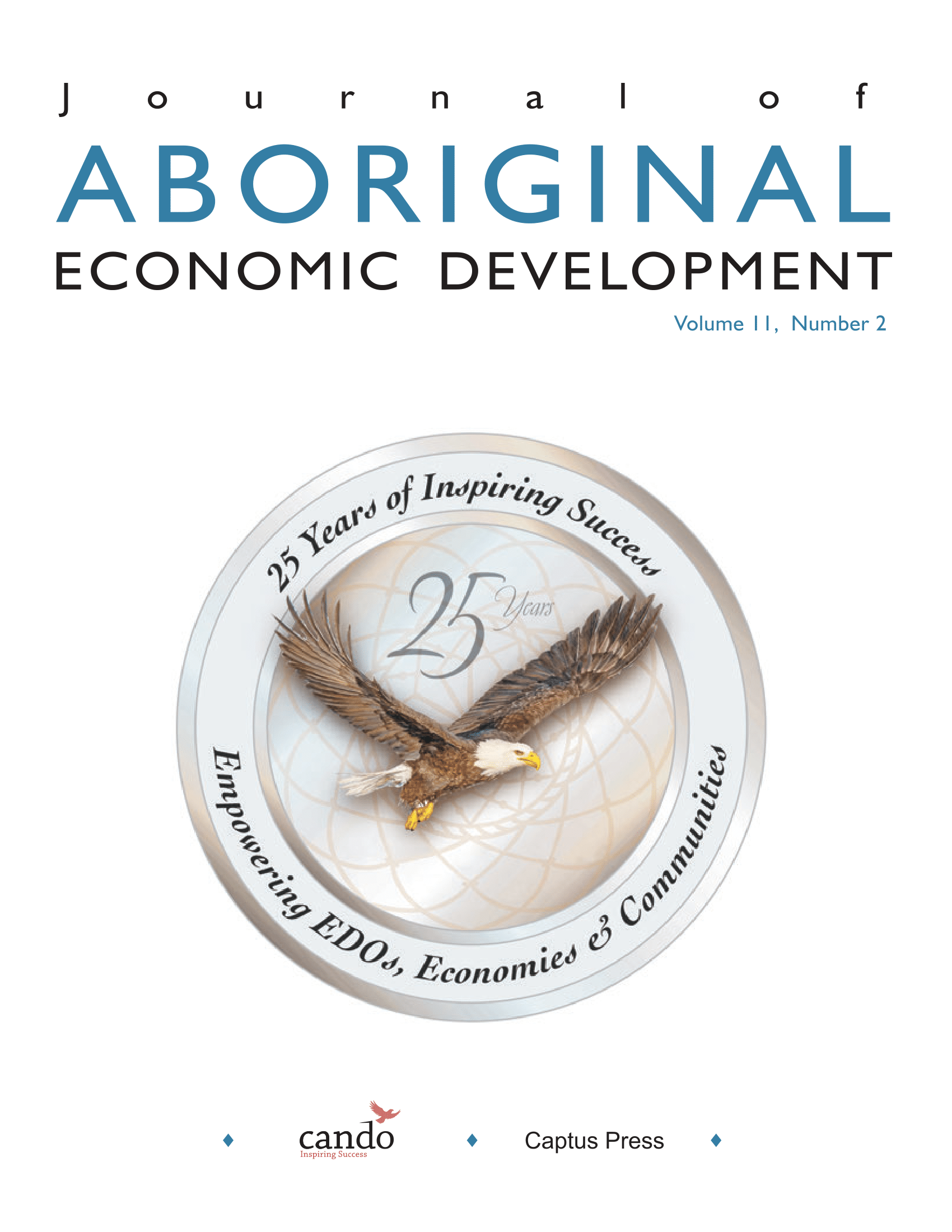Discovering the Meaning of Leadership: A Canadian First Nations Exploration
DOI:
https://doi.org/10.54056/DAGM6324Keywords:
Acculturation, Business And Economics, Cultural heritage, Culture, Ethnic Interests, Eurocentrism, Influence, Leadership, Native North Americans, Perceptions, Prototypes, Research, Social structure, Society, Indigenous , Indigenous economic development, Indigenous economic leadership, Indigenous community developmentAbstract
First Nations Canadians are in a unique cultural context, with values resulting from both traditional, heritage influences and Eurocentric Canadian influences. Different patterns of endorsing heritage versus mainstream values have resulted. This research examined leadership preferences in First Nations individuals. Linking acculturation patterns to descriptors of leadership attributes that enhance or inhibit outstanding leadership, characteristics of leadership prototypes were developed for members of four acculturative strategy groups. These leadership prototypes were then compared with existing academic leadership theories.
Downloads
References
Adair, R. (2008). Developing great leaders, one follower at a time. In R.E. Riggio, I. Chaleff, & J. Lipman-Blumen (Eds.), The art of followership (pp. 137–154). San Francisco, CA: Jossey-Bass.
Aycan, Z., Kanungo, R.N., Mendonca, M., Yu, K., Deller, J., Stahl, G., & Kurship, A. (2000). Impact of culture on human resource management practices: A 10-country comparison. Applied Psychology: An International Review, 49, 192–221.
Avolio, B.J., Walumbwa, F.O., & Weber, T.J. (2009). Leadership: Current theories, research, and future directions. Annual Review of Psychology, 60, 421–449. https://doi.org/10.1146/annurev.psycho.60.110707.163621
Baker, S.D. (2007). Followership: The theoretical foundation of a contemporary construct. Journal of Leadership and Organizational Studies, 14(1), 50–60.
Bass, B.M. (1985). Leadership: Good, better, best. Organizational Dynamics, 13(3), 26–40.
Bass, B.M. (1990). From transactional to transformational leadership: Learning to share the vision. Organizational Dynamics, 18(3), 19–31.
Berry, J.W. (1997). Immigration, acculturation, and adaptation. Applied Psychology: An International Review, 46(1), 5–68.
Davidov, E. & Depner, F. (2011). Testing for measurement equivalence of human values across online and paper-and-pencil surveys. Quality & Quantity, 45(2), 375–390. https://doi.org/10.1007/s11135-009-9297-9
Day, D.V., Gronn, P., & Salas, F. (2004). Leadership capacity in teams. Leadership Quarterly, 15, 857–880.
De Beuckelaer, A., & Lievens, F. (2009). Measurement equivalence of paper-and-pencil and Internet organisational surveys: A large scale examination in 16 countries. Applied Psychology: An International Review, 58(2), 336–361. https://doi.org/10.1111/j.1464-0597.2008.00350x
Den Hartog, D.N., House, R.J., Hanges, P.J., & Ruiz-Quintanilla, S.A. (1999). Culture specific and cross-culturally generalizable implicit leadership theories: Are attributes of charismatic/transactional leadership universally endorsed? Leadership Quarterly, 10(2), 219–256.
Gelfand, M.J., Erez, M., & Aycan, Z. (2007). Cross-cultural organizational behavior. Annual Review of Psychology, 58, 479–514. https://doi.org/10.1146/annurev.psych.58.11045.085559
Hanges, P.J. & Dickson, M.W. (2004). The development and validation of the GLOBE culture and leadership scales. In R.J. House, P.J. Hanges, M. Javidan, P.W. Dorfman, & V. Gupta (Eds.), Culture, Leadership, and Organizations: The GLOBE Study of 62 Societies (pp. 122–151). Thousand Oaks, CA: Sage.
House, R. & Javidan, M. (2004). Overview of GLOBE. In R.J. House, P.J. Hanges, M. Javidan, P.W. Dorfman, & V. Gupta (Eds.), Culture, Leadership, and Organizations: The GLOBE Study of 62 Societies (pp. 9–28). Thousand Oaks, CA: Sage.
House, R., Javidan, M., Hanges, P., & Dorfman, P. (2002). Understanding cultures and implicit leadership theories across the globe: An introduction to project GLOBE. Journal of World Business, 37, 3–10.
Indigenous Works. (n.d.) Business case for inclusion — Increasing market size. Retrieved from https://indigenousworks.ca/en/about/business-case- inclusion/increasing-market
Judge, T.A., & Piccolo, R.F. (2004). Transformational and transactional leadership: A meta-analytic test of their relative validity. Journal of Applied Psychology, 89(5), 755–768.
Kriger, M. & Seng, Y. (2005). Leadership with inner meaning: A contingency theory of leadership based on the worldviews of five religions. The Leadership Quarterly, 16, 771–806. https://doi.org/10.1016/j.leaqua.2005.07.007.
Lang, D.L. (1991). Transformational leadership is not charismatic leadership: Philosophical impoverishment in leadership continues. Human Resource Development Quarterly, 2(4), 397–402.
Lord, R.G. (2008). Followers’ cognitive and affective structures and leadership processes. In R.E. Riggio, I. Chaleff, & J. Lipman-Blumen (Eds.), The Art of Followership (pp. 255–266). San Francisco, CA: Jossey-Bass.
Lord, R.G., Brown, D.J., & Freiberg, S.J. (1999). Understanding the dynamics of leadership: The role of follower self-concepts in the leader/follower relationship. Organizational Behavior and Human Decision Processes, 78(3), 167–203.
Lord, R.G., Foti, R.J., & DeVader, C.L. (1984). A test of leadership categorization theory: Internal structure, information processing and leadership perceptions. Organizational Behavior and Human Performance, 34, 343–378.
Lord, R.G., & Maher, K.J. (1991). Leadership and information processing: Linking perceptions and performance. Boston: Unwind Hyman.
Maroosis, J. (2008). Leadership: A partnership in reciprocal following. In R.E. Riggio, I. Chaleff, & J. Lipman-Blumen (Eds.), The Art of Followership (pp. 25–40). San Francisco, CA: Jossey-Bass.
Meindl, J.R. (1995). The romance of leadership as a follower-centric theory: A social constructionist approach. Leadership Quarterly, 6(3), 329–341.
Meindl, J.R., Ehrlich, S.B., & Dukerich, J.M. (1985). The romance of leadership. Administrative Science Quarterly, 30(1), 78–102.
Mittal, R., & Dorfman, P.W. (2012). Servant leadership across cultures. Journal of World Business, 47, 555–570. https://doi.org/10.1016/j.jwb.2012.01.009
Ryder, A.G., Alden, L.E., & Paulhus, D.L. (2000). Is acculturation unidimensional or bidimensional? A head-to-head comparison in the prediction of personality, self-identity, and adjustment. Journal of Personality and Social Psychology, 79(1), 49–65. https://doi.org/10.1037/0022-3514-79.1.49
Schnarch, B. (2004). Ownership, control, access, and possession (OCAP) or self-determination applied to research. Journal of Aboriginal Health, 1(1), 80–95.
Shafer, E.L., Vieregge, M., & Younsoo, C. (2005). Cultural differences in perceived leadership styles. International Journal of Hospitality and Tourism Administration, 6(3), 65–88. https://doi.org/10.1300/J149v06n03_05.
Shamir, B., House, R.J., & Arthur, M.B. (1993). The motivational effects of charismatic leadership: A self-concept based theory. Organization Science, 4(4), 577–594.
Shaw, J.B. (1990). A cognitive categorization model for the study of intercultural management. Academy of Management Review, 10, 435–454.
Stonefish, T., & Kwantes, C.T. (2017). Values and acculturation: A First Nations exploration. International Journal of Intercultural Relations, 61, 63–76.
Thiagarajan, K.M., & Lukas, P.A. (1971). Personal values across cultures: A study of managers and students in India and the United States. The Journal of Social Psychology, 85(1), 139–140. https://doi.org/10.1080/00224545.1971.9918554
Thoroughgood, C.N., & Sawyer, K.B. (2018). Who wants to follow the leader? Using personality and work value profiles to predict preferences for charismatic, ideological, and pragmatic styles of leading. Journal of Business and Psychology, 33(2), 181–202.
Uhl-Bien, M., Marion, R., & McKelvery, B. (2007). Complexity leadership theory: shifting leadership from the Industrial Age to the Knowledge Era. Leadership Quarterly, 18, 298–318.
Uhl-Bien, M., & Pillai, R. (2007). The romance of leadership and the social construction of followership. In B. Shamir, R. Pillai, M.C. Bligh, & M. Uhl-Bien (Eds.), Follower-Centered Perspectives on Leadership (pp. 187–210). New York: Information Age Publishing Inc.
Yukl, G. (1999). An evaluation of conceptual weaknesses in transformational and charismatic leadership theories. Leadership Quarterly, 10(2), 285.
Downloads
Published
Issue
Section
License
Copyright (c) 2019 Cando

This work is licensed under a Creative Commons Attribution-NonCommercial-NoDerivatives 4.0 International License.




